
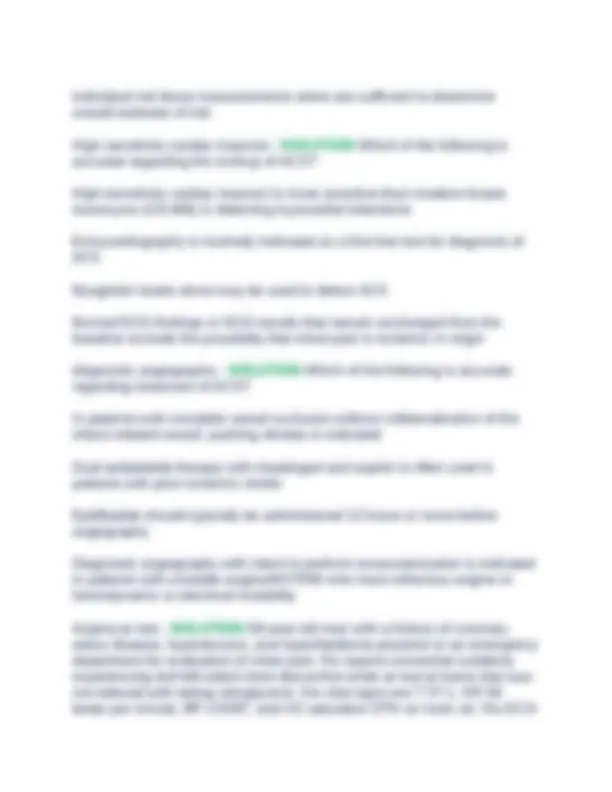
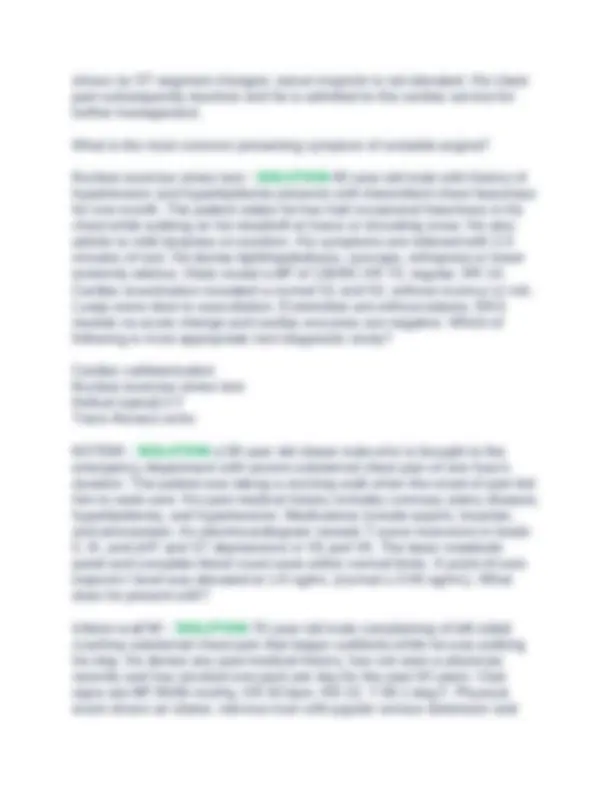
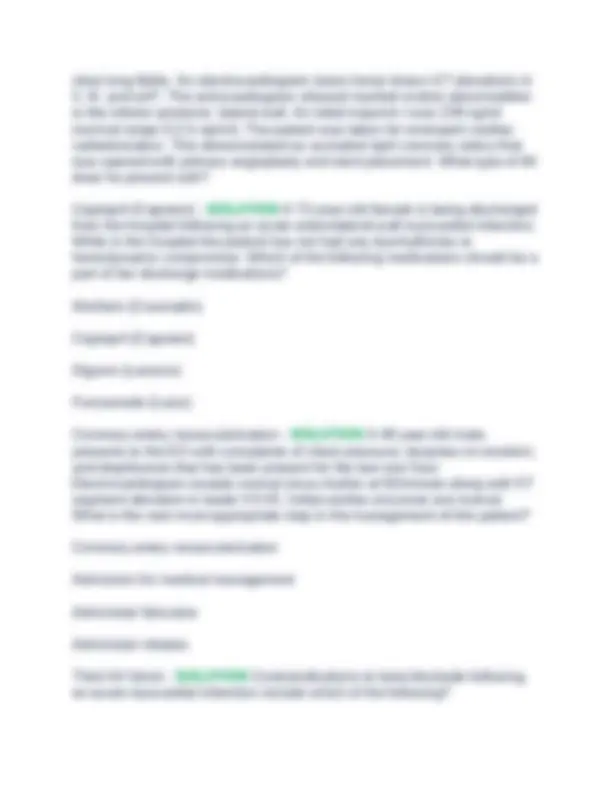
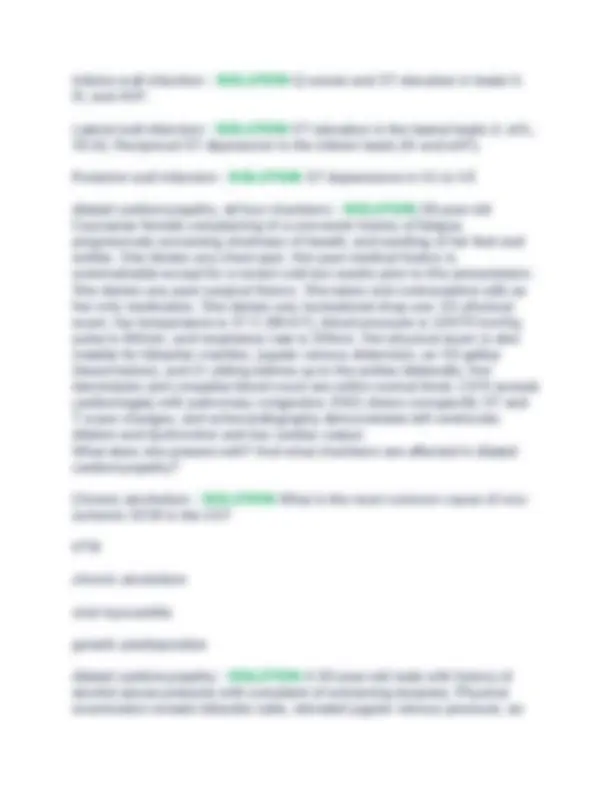
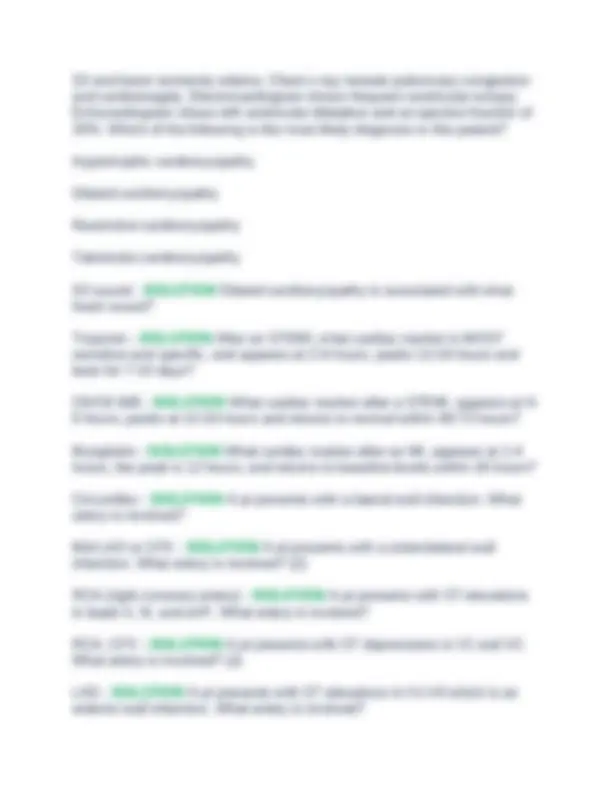
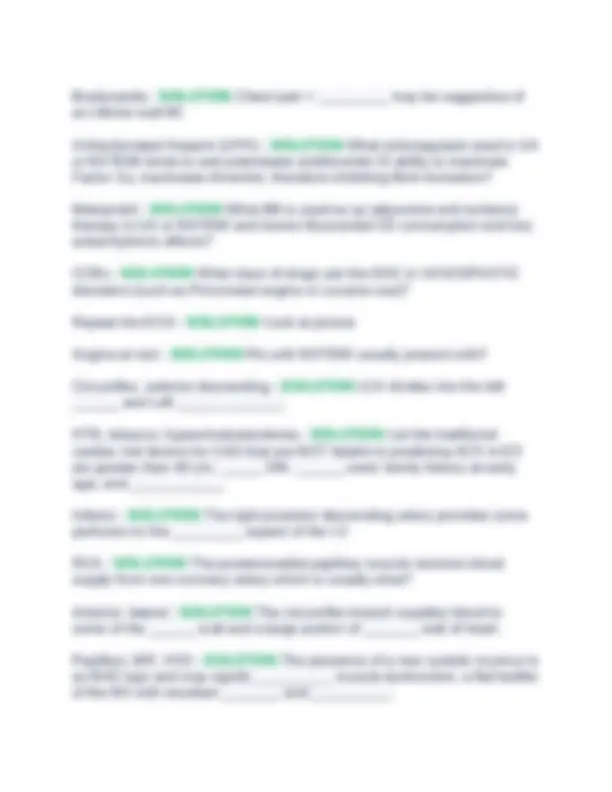
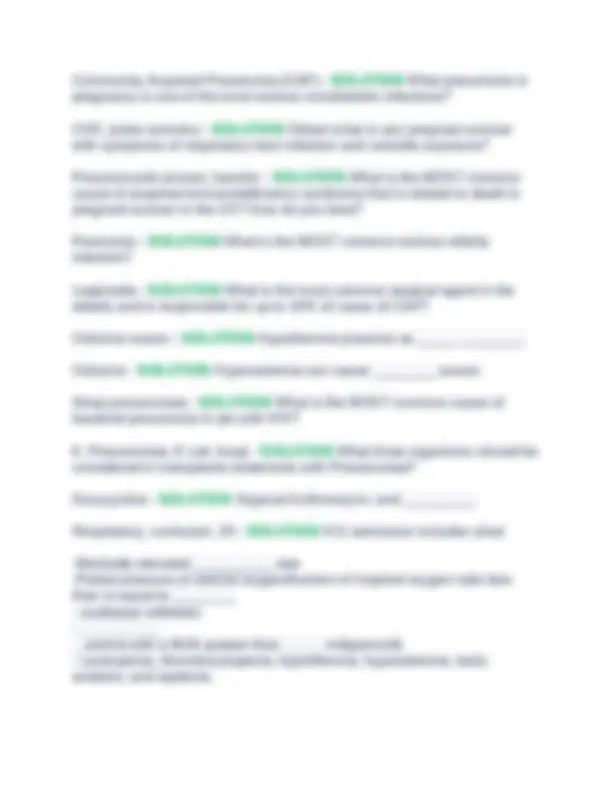
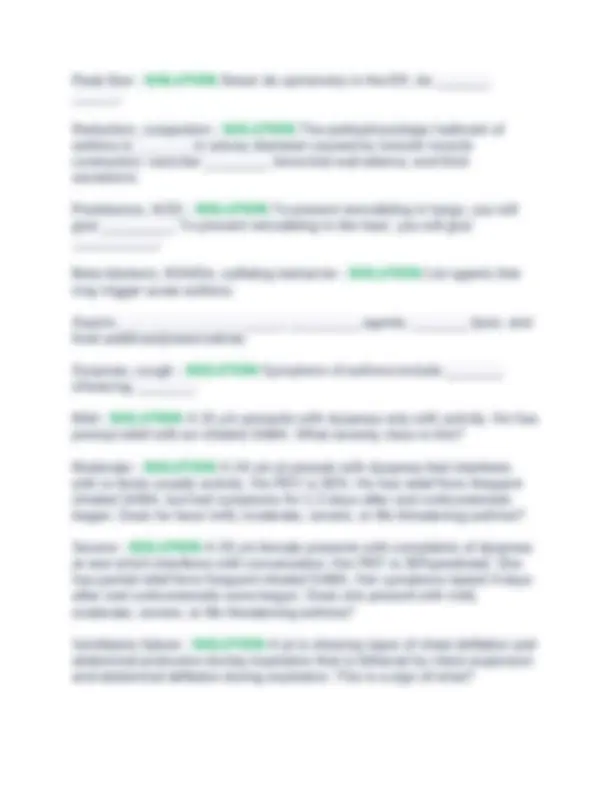
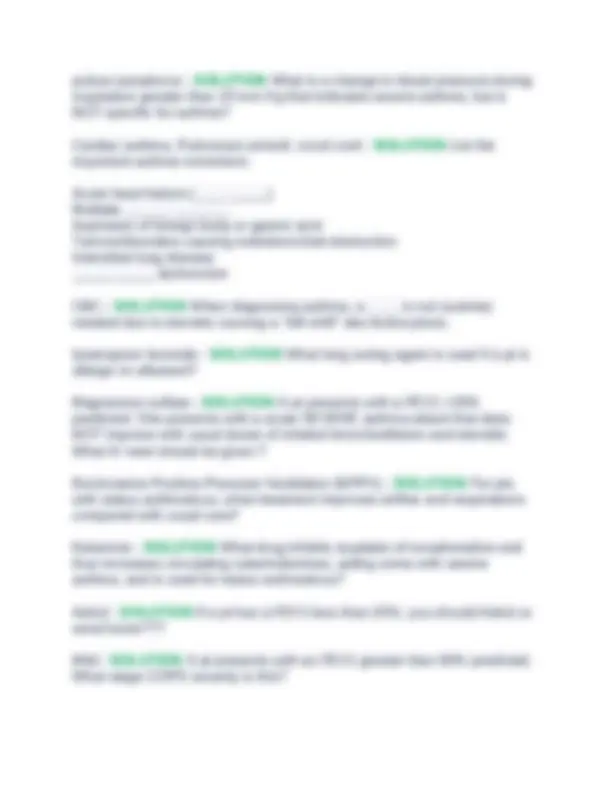
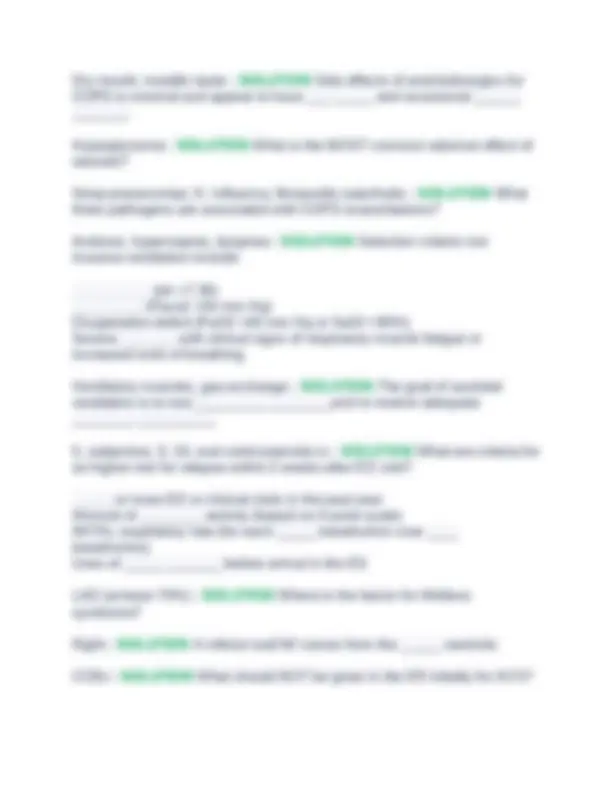

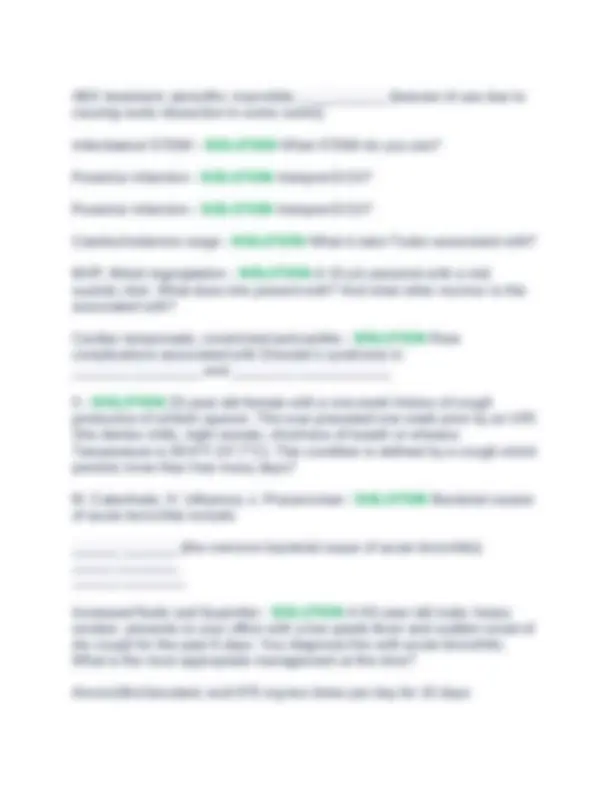
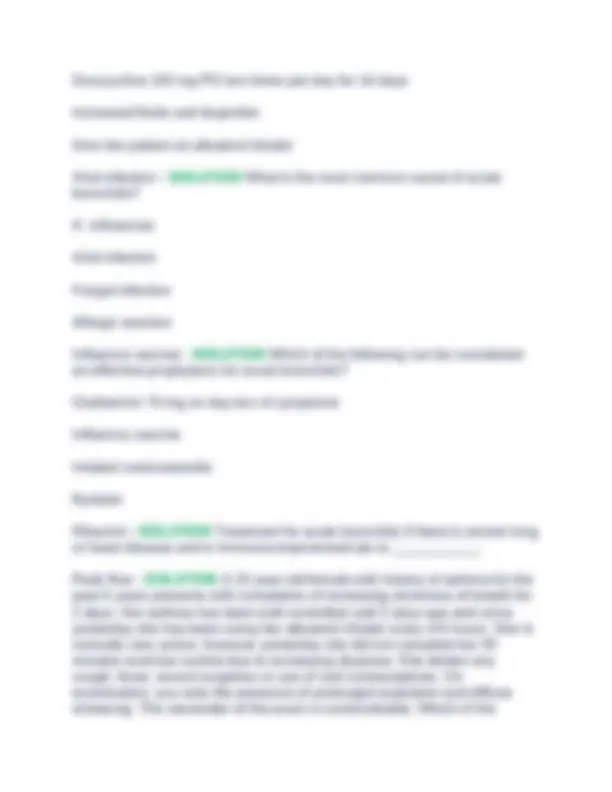
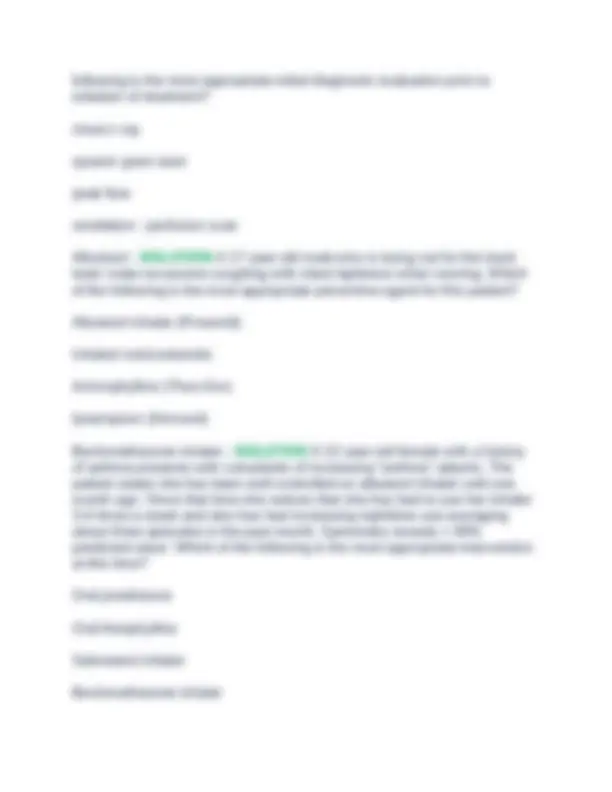
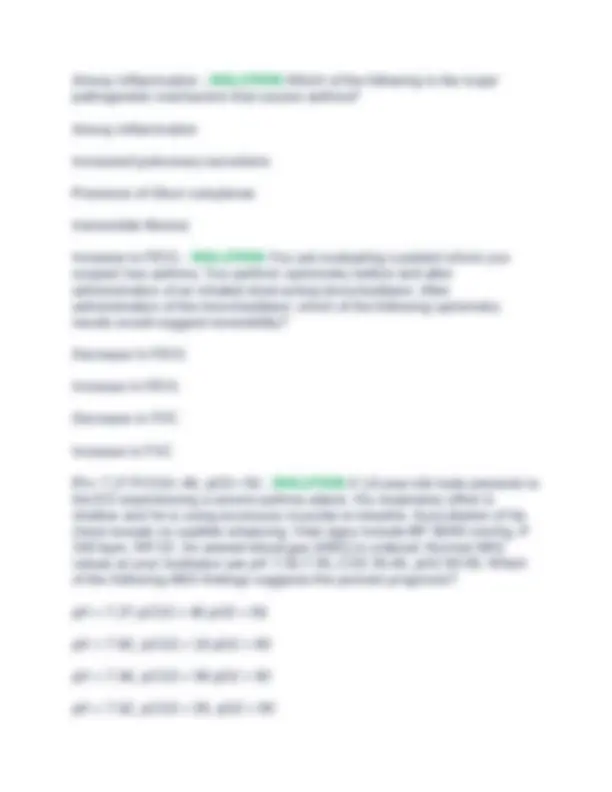
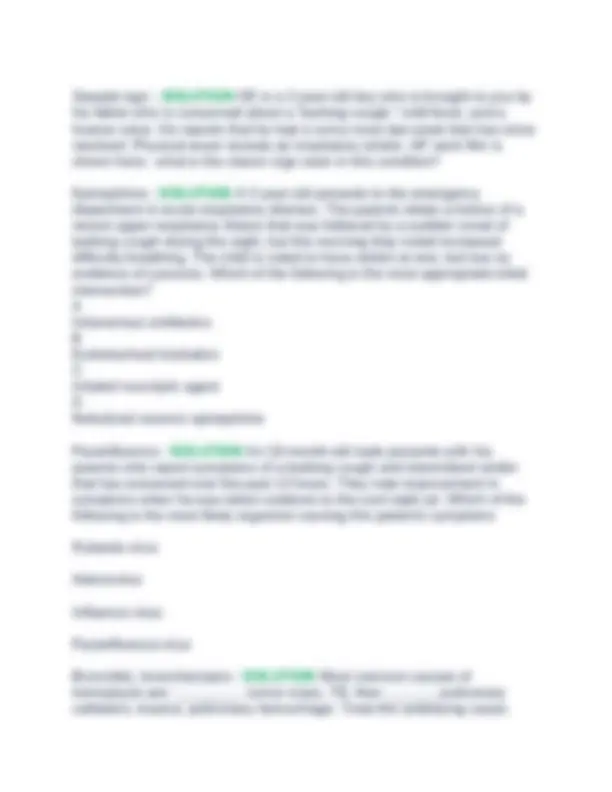
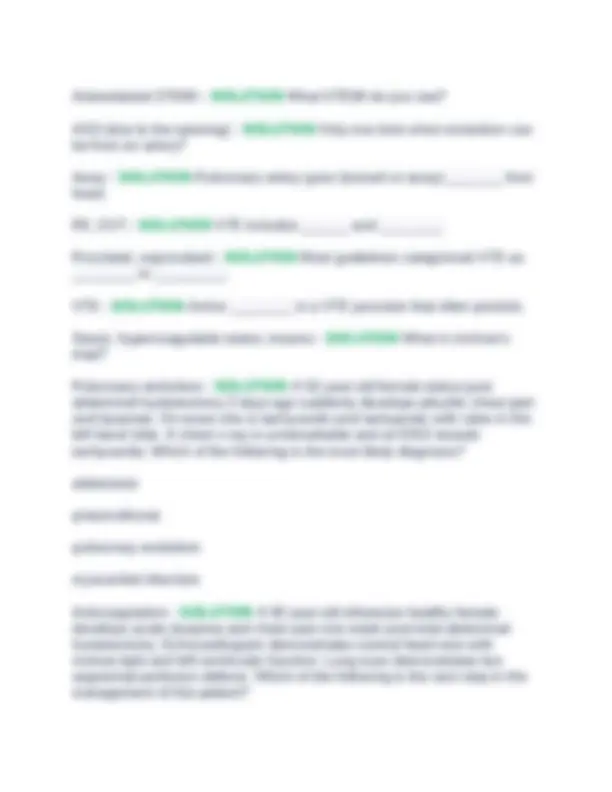
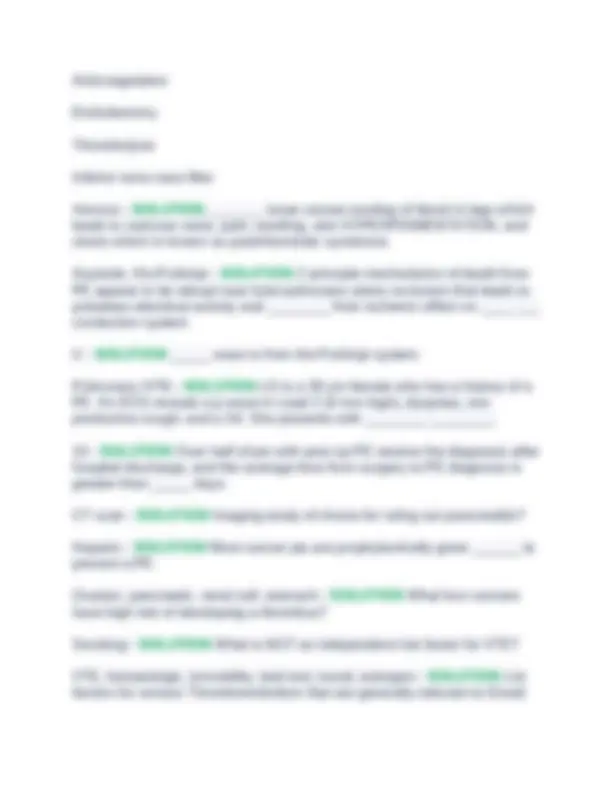
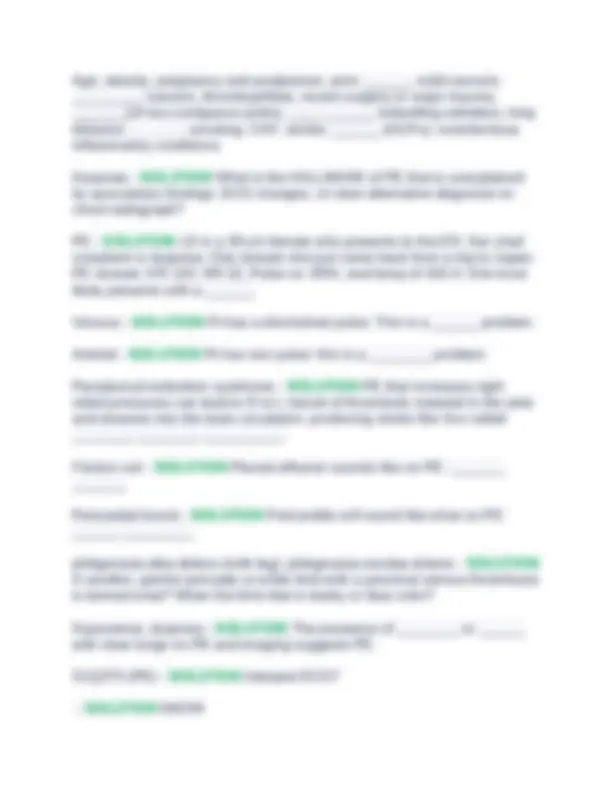
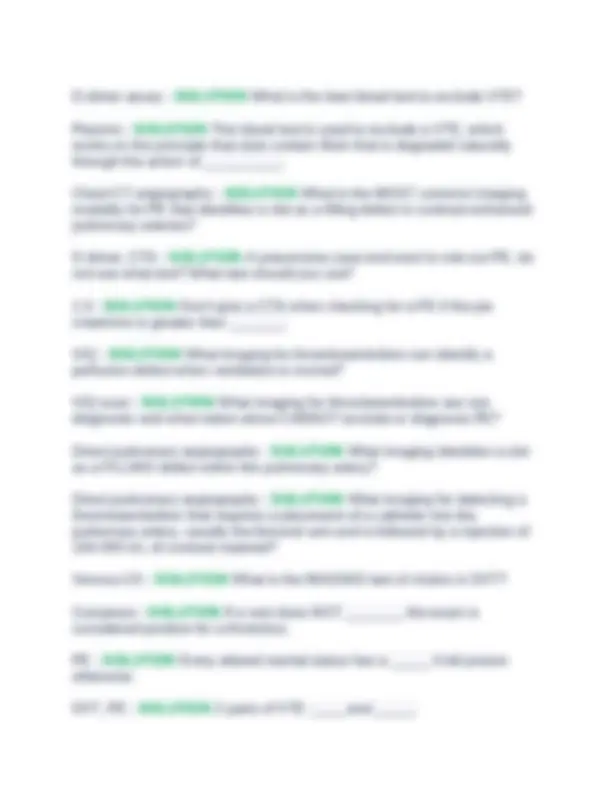



Study with the several resources on Docsity

Earn points by helping other students or get them with a premium plan


Prepare for your exams
Study with the several resources on Docsity

Earn points to download
Earn points by helping other students or get them with a premium plan
Community
Ask the community for help and clear up your study doubts
Discover the best universities in your country according to Docsity users
Free resources
Download our free guides on studying techniques, anxiety management strategies, and thesis advice from Docsity tutors
A comprehensive study guide for the e med exam 4, focusing on cardiopulmonary clinical correlations. It includes 220 questions and answers, covering topics such as nstemi, acs, risk factors for cardiovascular heart disease, screening for coronary heart disease, workup of acs, treatment of acs, and more. The questions are designed to test your understanding of these topics, making it an ideal resource for students preparing for the exam.
Typology: Exams
1 / 29

This page cannot be seen from the preview
Don't miss anything!






















NSTEMI - SOLUTION 58-year old obese male who is brought to the emergency department with severe substernal chest pain of one hour's duration. The patient was taking a morning walk when the onset of pain led him to seek care. His past medical history includes coronary artery disease, hyperlipidemia, and hypertension. Medications include aspirin, losartan, and atorvastatin. An electrocardiogram reveals T-wave inversions in leads II, III, and aVF and ST depressions in V5 and V6. The basic metabolic panel and complete blood count were within normal limits. A point-of-care troponin I level was elevated at 1.8 ng/mL (normal ≤ 0.06 ng/mL). What does he present with? 2 - SOLUTION 68-year-old female comes to the office for an annual physical examination. Her past medical history is significant for a 40-pack year cigarette smoking history. She takes no medications and has not been hospitalized for any surgery. Family medical history reveals that her mother is living, age 87, in good health without medical problems. Her father is deceased at age 45 from a motor vehicle crash. She has two siblings that are alive and well. From this information, how many identifiable risk factors for cardiovascular heart disease exist in this patient? 0 1 2 3 4 Most cases of ACS occur from disruption of a previously non severe lesion
Most cases of ACS occur from disruption of a previously nonsevere lesion Decreased blood glucose levels are risk factors for a major adverse cardiac event (MACE) in patients with suspected ACS ACS without elevation in demand typically excludes thrombosis or plaque hemorrhage Takotsubo syndrome only occurs in the presence of clinical coronary artery disease (CAD) Women may have coronary events more often without typical symptoms - SOLUTION Which of the following is accurate about the presentation of ACS? Exertional dyspnea due to ACS rarely resolves with pain and rarely improves with rest Hypertension typically indicates ventricular dysfunction due to myocardial ischemia Rales on pulmonary examination may suggest right ventricular dysfunction or aortic valve regurgitation Women may have coronary events more often without typical symptoms Low risk adults should not be screened using stress myocardial perfusion imaging - SOLUTION Which of the following is accurate regarding screening for coronary heart disease (CHD), according to American College of Physicians (ACP) guidelines? Cardiac screening improves patient outcomes, even in asymptomatic, low- risk adults The screening of asymptomatic, low-risk adults for cardiac disease should include resting or stress electrocardiography or echocardiography Low-risk adults should not be screened using stress myocardial perfusion imaging
shows no ST-segment changes; serum troponin is not elevated. His chest pain subsequently resolves and he is admitted to the cardiac service for further management. What is the most common presenting symptom of unstable angina? Nuclear exercise stress test - SOLUTION 60 year-old male with history of hypertension and hyperlipidemia presents with intermittent chest heaviness for one month. The patient states he has had occasional heaviness in his chest while walking on his treadmill at home or shoveling snow. He also admits to mild dyspnea on exertion. His symptoms are relieved with 2- minutes of rest. He denies lightheadedness, syncope, orthopnea or lower extremity edema. Vitals reveal a BP of 130/90, HR 70, regular, RR 14. Cardiac examination revealed a normal S1 and S2, without murmur or rub. Lungs were clear to auscultation. Extremities are without edema. EKG reveals no acute change and cardiac enzymes are negative. Which of following is most appropriate next diagnostic study? Cardiac catheterization Nuclear exercise stress test Helical (spiral) CT Trans thoracic echo NSTEMI - SOLUTION a 58-year old obese male who is brought to the emergency department with severe substernal chest pain of one hour's duration. The patient was taking a morning walk when the onset of pain led him to seek care. His past medical history includes coronary artery disease, hyperlipidemia, and hypertension. Medications include aspirin, losartan, and atorvastatin. An electrocardiogram reveals T-wave inversions in leads II, III, and aVF and ST depressions in V5 and V6. The basic metabolic panel and complete blood count were within normal limits. A point-of-care troponin I level was elevated at 1.8 ng/mL (normal ≤ 0.06 ng/mL). What does he present with? Inferior wall MI - SOLUTION 70-year-old male complaining of left-sided crushing substernal chest pain that began suddenly while he was walking his dog. He denies any past medical history, has not seen a physician recently and has smoked one pack per day for the past 50 years. Vital signs are BP 85/50 mmHg, HR 50 bpm, RR 22, T 99.1 deg F. Physical exam shows an obese, nervous man with jugular venous distension and
clear lung fields. An electrocardiogram (seen here) shows ST elevations in II, III, and aVF. The echocardiogram showed marked motion abnormalities in the inferior posterior, lateral wall. An initial troponin I was 238 ng/ml (normal range 0-2.5 ng/ml). The patient was taken for emergent cardiac catheterization. This demonstrated an occluded right coronary artery that was opened with primary angioplasty and stent placement. What type of MI does he present with? Captopril (Capoten) - SOLUTION A 72-year-old female is being discharged from the hospital following an acute anterolateral wall myocardial infarction. While in the hospital the patient has not had any dysrhythmias or hemodynamic compromise. Which of the following medications should be a part of her discharge medications? Warfarin (Coumadin) Captopril (Capoten) Digoxin (Lanoxin) Furosemide (Lasix) Coronary artery revascularization - SOLUTION A 48 year-old male presents to the ED with complaints of chest pressure, dyspnea on exertion, and diaphoresis that has been present for the last one hour. Electrocardiogram reveals normal sinus rhythm at 92/minute along with ST segment elevation in leads V3-V5. Initial cardiac enzymes are normal. What is the next most appropriate step in the management of this patient? Coronary artery revascularization Admission for medical management Administer lidocaine Administer nitrates Third AV block - SOLUTION Contraindications to beta blockade following an acute myocardial infarction include which of the following?
Coronary artery bypass grafting (CABG) Streptokinase Percutaneous coronary intervention (PCI) Warfarin (Coumadin Previous hemorrhagic stroke - SOLUTION Which of the following is an absolute contraindication to thrombolytic therapy in a patient with an acute ST segment elevation myocardial infarction? history of severe hypertension presently controlled current use of anticoagulation therapy previous hemorrhagic stroke active peptic ulcer disease Inferior - SOLUTION A 59-year-old male with history of hypertension and dyslipidemia presents with complaint of substernal chest pain for two hours. The pain woke him from sleep, does not radiate, and is associated with nausea and diaphoresis. Electrocardiogram reveals ST segment elevation in leads II, III, and AVF. Which of the following walls of the ventricle is most likely at risk? Anterior Inferior Lateral Posterior Anterior wall infarction - SOLUTION Q waves and ST elevation in leads I, AVL, and V2 to V6.
Inferior wall infarction - SOLUTION Q waves and ST elevation in leads II, III, and AVF. Lateral wall infarction - SOLUTION ST elevation in the lateral leads (I, aVL, V5-6). Reciprocal ST depression in the inferior leads (III and aVF). Posterior wall infarction - SOLUTION ST depressions in V1 to V dilated cardiomyopathy, all four chambers - SOLUTION 28-year-old Caucasian female complaining of a one-week history of fatigue, progressively worsening shortness of breath, and swelling of her feet and ankles. She denies any chest pain. Her past medical history is unremarkable except for a recent cold two weeks prior to this presentation. She denies any past surgical history. She takes oral contraceptive pills as her only medication. She denies any recreational drug use. On physical exam, her temperature is 37 C (98.6 F), blood pressure is 120/70 mmHg, pulse is 84/min, and respiratory rate is 20/min. Her physical exam is also notable for bibasilar crackles, jugular venous distension, an S3 gallop (heard below), and 2+ pitting edema up to the ankles bilaterally. Her electrolytes and complete blood count are within normal limits. CXR reveals cardiomegaly with pulmonary congestion, EKG shows nonspecific ST and T wave changes, and echocardiography demonstrates left ventricular dilation and dysfunction and low cardiac output. What does she present with? And what chambers are affected in dilated cardiomyopathy? Chronic alcoholism - SOLUTION What is the most common cause of non- ischemic DCM in the US? HTN chronic alcoholism viral myocarditis genetic predisposition dilated cardiomyopathy - SOLUTION A 50-year-old male with history of alcohol abuse presents with complaint of worsening dyspnea. Physical examination reveals bibasilar rales, elevated jugular venous pressure, an
Bradycardia - SOLUTION Chest pain + _________ may be suggestive of an inferior wall MI. Unfractionated Heparin (UFH) - SOLUTION What anticoagulant used in UA or NSTEMI binds to and potentiates antithrombin III ability to inactivate Factor Xa, inactivates thrombin, therefore inhibiting fibrin formation? Metoprolol - SOLUTION What BB is used as as adjunctive anti-ischemic therapy in UA or NSTEMI and lowers Myocardial O2 consumption and has antiarrhythmic effects? CCBs - SOLUTION What class of drugs are the DOC in VASOSPASTIC disorders (such as Prinzmetal angina or cocaine use)? Repeat the ECG - SOLUTION Look at picture Angina at rest - SOLUTION Pts with NSTEMI usually present with? Circumflex, anterior descending - SOLUTION LCA divides into the left ______ and Left ______ _______. HTN, tobacco, hypercholesterolemia - SOLUTION List the traditional cardiac risk factors for CAD that are NOT helpful in predicting ACS in ED pts greater than 40 y/o: _____, DM, ______ used, family history at early age, and ____________ Inferior - SOLUTION The right posterior descending artery provides some perfusion to the _________ aspect of the LV. RCA - SOLUTION The posteromedial papillary muscle receives blood supply from one coronary artery which is usually what? Anterior, lateral - SOLUTION The circumflex branch supplies blood to some of the ______ wall and a large portion of _______ wall of heart. Papillary, MR, VSD - SOLUTION The presence of a new systolic murmur is an BAD sign and may signify __________ muscle dysfunction, a flail leaflet of the MV with resultant _______, and __________.
True posterior - SOLUTION Electrocardiographic findings show initial R waves in V1 and V2 >0.04 seconds and R/S ratio greater than or equal to
Community Acquired Pneumonia (CAP) - SOLUTION What pneumonia in pregnancy is one of the most serious nonobstetric infections? CXR, pulse oximetry - SOLUTION Obtain what in any pregnant woman with symptoms of respiratory tract infection and varicella exposure? Pneumocystis jiroveci, bactrim - SOLUTION What is the MOST common cause of acquired immunodeficiency syndrome that is related to death in pregnant women in the US? How do you treat? Pnemonia - SOLUTION What is the MOST common serious elderly infection? Legionella - SOLUTION What is the most common atypical agent in the elderly and is responsible for up to 10% of cases of CAP? Osborne waves - SOLUTION Hypothermia presents as _____ ________. Osborne - SOLUTION Hyponatremia can cause ________ waves. Strep pneumoniae - SOLUTION What is the MOST common cause of bacterial pneumonia in pts with HIV? K. Pneumoniae, E.coli, fungi - SOLUTION What three organisms should be considered in transplants treatments with Pneumoniae? Doxycycline - SOLUTION Atypical:Azithromycin, and _________. Respiratory, confusion, 20 - SOLUTION ICU admission includes what: -Markedly elevated __________ rate -Partial pressure of arterial oxygen/fraction of inspired oxygen ratio less than or equal to ________
_ uremia with a BUN greater than _____ miligrams/dL
Peak flow - SOLUTION Never do spirometry in the ER, do _______ ______. Reduction, congestion - SOLUTION The pathophysiologic hallmark of asthma is _______ in airway diameter caused by smooth muscle contraction, vascular ________, bronchial wall edema, and thick secretions. Prednisone, ACEI - SOLUTION To prevent remodeling in lungs, you will give _________. To prevent remodeling in the hear, you will give ___________. Beta blockers, NSAIDs, sulfating tartrazine - SOLUTION List agents that may trigger acute asthma: Aspirin, ___ _______, _________, _________ agents, _______ dyes, and food additives/preservatives Dyspnea, cough - SOLUTION Symptoms of asthma include _______, wheezing, _______. Mild - SOLUTION A 15 y/o presents with dyspnea only with activity. He has prompt relief with an inhaled SABA. What severity class is this? Moderate - SOLUTION A 24 y/o pt presets with dyspnea that interferes with or limits usually activity. His PEV is 55%. He has relief from frequent inhaled SABA, but had symptoms for 1-2 days after oral corticosteroids began. Does he have mild, moderate, severe, or life threatening asthma? Severe - SOLUTION A 29 y/o female presents with complaints of dyspnea at rest which interferes with conversation. Her PEF is 35%predicted. She has partial relief form frequent inhaled SABA. Her symptoms lasted 4 days after oral corticosteroids were begun. Does she present with mild, moderate, severe, or life threatening asthma? Ventilatory failure - SOLUTION A pt is showing signs of chest deflation and abdominal protrusion during inspiration that is followed by chest expansion and abdominal deflation during expiration. This is a sign of what?
Moderate - SOLUTION A COPD pt presents with a FEV1 of 60% predicted. What classification is this? Severe - SOLUTION A pt presents with a FEV1 of 45% predicted. What classification of COPD does he present with? Very severe - SOLUTION A pt presents with a FEV1 less than 30% predicted. What classification of COPD does he present with? Polycythemia, severe - SOLUTION A COPD pt presents with facial vascular engorgement. This is a clinical sign of secondary _________ showing _______ COPD. Severe, incubated, ventilated - SOLUTION A COPD pt presents with hypercarbia. This is a sign of _________ COPD. This pt should be _______ and ________. Chronic bronchitis - SOLUTION What is not radiographically apparent unless bronchiectasis is present? Parenchymal - SOLUTION A CXR reveals the following; increased AP chest diameter, flattened diaphragms, increased ________ lucency and attenuation of pulmonary arterial vascular shadows. CHF - SOLUTION A BNP greater than 500 most likely indicates what? O2 therapy - SOLUTION What long term treatment therapy reduces COPD mortality? 60, 90 - SOLUTION The goal of long term O2 ternary is to increase the baseline partial pressure of arterial oxygen to greater than or equal to ______ mmHg or the SaO2 to greater than or equal to _______ % at rest. Corticosteroids, 50, systemic - SOLUTION A regular tax of inhaled steroids is undated for COPD pts with the following: A documented spirometric response to inhaled __________ Those with FEV1 of less than _____% or those with predicted and recurrent exacerbations requiring antibiotic treatment or __________ corticosteroids.
Azithromycin - SOLUTION What antibiotic may be used daily to decrease acute exacerbations in older pts and those with milder GOLD staging? Antihistamines, mucolytics - SOLUTION For a chronically compensated COPD pt , there should be limited use of ________, antitussives, __________ and decongestants. Smoking cessation - SOLUTION What is the ONLY intervention that can reduce both the rate of decline in lung function and mortality from respiratory causes of COPD? Troponins - SOLUTION You should obtain an ECG or ________ in those with chest pain or dyspnea and risk factors for ACS. Hypoxemia (arterial saturation less than 90%) - SOLUTION What is the MOST life threatening feature of an acute exacerbation of COPD? Tachypnea, HTN, mental status - SOLUTION Signs of hypoxemia include: _______, tachycardia, systemic _________, cyanosis and change in _______ ________. Respiratory - SOLUTION All COPD pts have _________ acidosis. 60, 90 - SOLUTION Respiratory failure is characterized by an arterial of PaO2 less than ______ or arterial SaO2 less than ________ in room air. Respiratory acidosis - SOLUTION What is present if the partial pressure of carbon dioxide is greater than 44 mm H? Oxygenation, underlying cause - SOLUTION For acute exacerbation of COPD, the goals of treatment is to correct tissue _________, alleviate reversible bronchospasm, and treat ______ _____. Oxygen - SOLUTION What treatment for acute exacerbation of COPD is given to raise the PAO2 to greater than 60 or SaO2 greater than 90%? B2 adrenergic agonist, anticholinergic agents - SOLUTION What are first line therapies in the management of acute, severe COPD?
Right - SOLUTION Aortic regurgitation will look like ______ sided heart failure. Yes - SOLUTION Is the circumflex artery and 1st diagonal branch the same thing? ASA - SOLUTION What is the FIRST drug given for MI pt? Hyperacute anteroseptal STEMI - SOLUTION What does this ECG represent? Hyperacute anteroseptal STEMI - SOLUTION What does this ECG represent? High lateral STEMI ("South African flag sign") - SOLUTION What does this ECG represent? Higher lateral STEMI - SOLUTION What presents on this ECG? Inferior wall STEMI - SOLUTION Interpret this ECG? Recent inferolateral STEMI - SOLUTION Interpret this ECG? Inferior wall MI - SOLUTION Interpret this eCG? High lateral STEMI - SOLUTION what STEMI do you see? High lateral STEMI - SOLUTION What STEMI do you see? Anterolateral STEMI - SOLUTION What STEMI do you see? Sinus tachycardia - SOLUTION PE presents with clear to auscultation and ______ ________. Hyponatremia, fluroquinolones - SOLUTION Lab findings for pneumococcal pneumonia: Leukocytosis
Bilirubin or hepatic enzymes
ABX treatment: penicillin, macrolide, ___________ (beware of use due to causing aortic dissection in some cases). Inferolateral STEMI - SOLUTION What STEMI do you see? Posterior infarction - SOLUTION Interpret ECG? Posterior infarction - SOLUTION Interpret ECG? Catehocholamine surge - SOLUTION What is tako-Tsubo associated with? MVP, Mitral regurgitation - SOLUTION A 15 y/o presents with a mid systolic click. What does she present with? And what other murmur is this associated with? Cardiac tamponade, constricted pericarditis - SOLUTION Rare complications associated with Dressler's syndrome is: _______ _________ and ________ ____________ 5 - SOLUTION 23-year-old-female with a one week history of cough productive of whitish sputum. This was preceded one week prior by an URI. She denies chills, night sweats, shortness of breath or wheeze. Temperature is 99.9°F (37.7°C). This condition is defined by a cough which persists more than how many days? M. Catarrhalis, H. Influenza, s. Pneumoniae - SOLUTION Bacterial causes of acute bronchitis include: ______ _______ (the common bacterial cause of acute bronchitis)
Increased fluids and ibuprofen - SOLUTION A 63-year-old male, heavy smoker, presents to your office with a low-grade fever and sudden onset of dry cough for the past 6 days. You diagnose him with acute bronchitis. What is the most appropriate management at this time? Amoxicillin/clavulanic acid 875 mg two times per day for 10 days